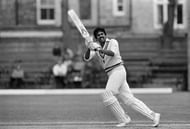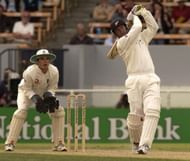There have been a lot of instances in world cricket where we have seen the unexpected happen. Minnows have gone on and defeated world class sides, and mediocre players have suddenly shown exceptional talent out of nowhere. There are also numerous examples of great players, much to everyone’s surprise, starting off their career with a few dull, forgettable innings before finally establishing themselves at the highest level.Marvan Atapattu, for example, scored just 1 run from his first three Tests and was consequently dropped for a period of two years after each of those failures. He went back to first class cricket each time and piled on the runs, thereby granting him further opportunities to establish himself at the Test level which he, to his credit, took full advantage of. Here are five batting performances which surprised the cricketing public:
#1 Jason Gillespie (201* vs Bangladesh, Australia in Bangladesh, 2006)

You are playing against Australia at home. You lose the first Test despite notching up a total of 427 in the first innings. You are, then, bowled out for 197 on the first day of the 2nd Test after winning the toss and batting first. And to top it all, a night watchman who had averaged below 10 before the said game scores a double hundred against you. It doesn’t get much worse and more humiliating than this.
After having a nice day with the ball with figures of 3/11 from 5 overs, Gillespie came in at No.3 as night watchman on the fall of Matthew Hayden’s wicket, and saw the day through with 5 runs to his name. The next day, which saw only 35 overs of play owing to interruptions by rain, was again survived by Gillespie who looked to be getting more comfortable at the wicket by the minute.
He remained unbeaten along with Ponting at the end of the day with the score reading 197/2. Day 3 saw some 50 overs, and the lone wicket to fall was Ponting’s. Gillespie continued batting and reached his hundred just before tea, while his partner Hussey got to his the next day even as Bangladesh looked clueless about how to send the Gillespie back to the pavilion. The runs kept piling up as the Aussies eclipsed the 400 run-mark, followed by Gillespie reaching 150 and Australia making 500.
And, all of a sudden, Gillespie had reached the magical 200 mark. It was as if nothing could go wrong for the men from Down Under. In regards to Gillespie’s effort, it was not one of those hasty, out of the blue knocks that a tailender scores every once in a while. It was a rather classy, well-planned textbook double hundred, which saw him take his time to get his eye in before freeing his arms once he got a hang of the wicket and the conditions. Gillespie hit 26 fours and 2 sixes in an innings that lasted 425 balls, spanning over four days and 9 hours.
Bangladesh, who are usually used to setbacks when facing quality sides (or any side for that matter), could have perhaps digested a hundred from a Ponting or Hayden, but they couldn’t have been ready for something like this. They never succeeded in getting him out, with his innings coming to an end only after Ponting’s declaration the moment he got his double hundred. Up against the task of covering a deficit of 384 if they wanted to make Australia bat again, Bangladesh fell way short and were all out for 304. Gillespie was rightly awarded the Man-Of-The-Match as well as the series.
#2 Kapil Dev (175* v Zimbabwe, World Cup, 1983)

The 1983 World Cup was Kapil Dev’s tournament, not just as player but also as captain. Regarded as one of the most iconic innings by an Indian captain, Kapil Dev’s 175 is a fond memory for every Indian fan fortunate enough to have been around at the time when he played this gem of an innings.
Courtesy of the knock, he made sure that India progressed to subsequent rounds in the tournament, a tournament which they eventually ended up winning. It was most certainly curtains for India if they had lost against Zimbabwe. And it looked that way when India’s top 5 were back in the hut with only 17 on the board, batting first at Tunbridge Wells.
Kapil Dev was joined by Roger Binny at the middle, and they started the rebuilding process. Kapil, who had never got an ODI hundred earlier, decided this to be the day when he would do so, and what a hundred it was. The Indian innings, which was in danger of being wrapped up early at one point, lasted the full 60 overs, with the Indians putting up 266 for the Zimbabweans to chase.
Although Binny and then Ravi Shastri had fallen in quick succession when the score was less than a 100, Kapil continued playing his shots regardless of who was there at the other end, and his approach paid off massively.
It could be categorized as the most single-handed batting effort ever, with the second highest scorer being No. 10 batsman Syed Kirmani, who scored 24. He was by no means a slouch with the bat, but with an ODI batting average of below 25, this big hundred was somewhat of a surprise to everyone.
This, after all, would be the only ODI hundred he would ever score. However, he succeeded in ensuring that it was a special one and would be remembered and recounted for ages to come.
#3 Misbah-ul-Haq (101 v Australia, Australia v Pakistan, 2014)
Nobody could have seen this coming. Misbah surprised everyone around him, including himself. It doesn’t happen every day that a batsman with a Gavaskar-like reputation of playing slowly equals Sir Viv’s record of the fastest Test century off just 56 balls.
Pakistan already had the upper hand in the Test with a 309-run lead that was carried on from the first innings. As they came out to bat the second time, captain Misbah would have wanted a quick flurry of runs before he could put Australia in to bat once again.
And he decided to take matters into his own hands, much like a captain should. He slaughtered the Australian attack, and made it look way more ordinary than it actually was. He reserved special treatment for Steven Smith, who he hit for 38 in the 11 balls he faced, including 4 sixes – two over long-on and two in the mid-wicket region.
He also took a liking to Mitchell Starc and Peter Siddle in an innings which looked rather like a response to an extended period of restricting and bottling up one’s natural instincts. He had got a hundred in the previous innings as well, and helped Pakistan seal the series 2-0.
#4 Yusuf Pathan (123* v New Zealand, New Zealand in India, 2010)
Playing at the Chinnaswamy stadium in Bangalore, New Zealand had set India a challenging target of 315. Yusuf Pathan, who had shown his destructive ability in domestic cricket and the IPL, was yet to do something worthwhile on the international stage. He had just the two fifties to his name before this game, and his first hundred couldn’t have come in better style.
He joined Rohit Sharma when the 4th wicket fell and the Indians had posted just 108 on the board. They played cautious yet smart cricket, stringing together an 80 run-stand before Sharma departed for 44. India still needed 128 to win from just under 17 overs, and one might have as well felt that the match was out of India’s grasp going by Pathan’s not so reliable reputation.
But surprisingly, no Indian wickets were to fall from then on. Pathan rose to the occasion and delivered. With Saurabh Tiwary at the other end, he started taking calculated heaves at the ball, and he never looked back once he was sure that he had found his flow. This was when the balance of the game shifted India’s way. He hit Kyle Mills for three boundaries and a six to gather 21 runs in the 43rd over of the innings, and brought up his hundred shortly after.
His 123 not out, which came in just 96 balls, comprised of 7 fours and as many sixes, and gave India a 5-wicket victory.
#5 Nathan Astle (222 v England, England in New Zealand, 2002)

He was never doubted for his skills with the bat. But what he did to England that day was nothing short of carnage. Nobody, not even the New Zealanders themselves, could have seen this coming. With a career strike rate in Tests and ODIs of 49.60 and 72.64, respectively, Astle was not considered the kind of player who could bludgeon a bowling attack at his mercy.
But the fact that made the fastest double hundred in the history of Test cricket, taking just 153 deliveries to reach the landmark, indicates that he was capable of doing so. The Kiwi came to the crease with the hosts batting at 119/3, chasing a mammoth target of 550. He kept his cool till time thime that there were recognised batters at the other end. But with wickets falling at regular intervals, Astle decided to take charge of the situation, and what followed was sheer brilliance from his bat.
The England seamers had never looked this miserable in the game so far. Caddick and Hoggard, who had taken 9 and 7 wickets in the game till then, were knocked to all corners of the park as a happily stunned Christchurch crowd watched on in awe, unable to believe what was unfolding before them. Astle hit a total of 28 fours and 11 sixes as part of his unbelievable effort. He made a mockery of the previous fastest double hundred by Gilchrist, who took 212 balls to reach there.
Chris Cairns, who was at the other end, was happy to let him take majority of the strike as he put on one of the best displays of clean-hitting ever witnessed. He almost pulled off an impossible victory which looked out of bounds to begin with. England had started to feel the pressure when the required runs came to double figures, and heaved a sigh of relief when he got out, giving a simple catch to wicket-keeper James Foster off the bowling of Hoggard.
Although England eventually won by a seemingly comfortable margin of 98 runs, it seemed anything but when Astle was going all guns blazing.
Follow IPL Auction 2025 Live Updates, News & Biddings at Sportskeeda. Get the fastest updates on Mega-Auction and cricket news
